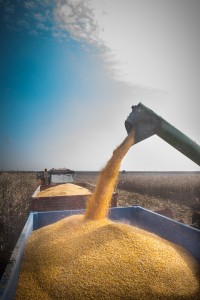Conversations
Food For Thought: Locals weigh in on the great GMO debate
BY VANESSA ROSET
December, 2015
GMOs have been a bit of a hot topic recently, their very mention often initiating a passionate response. They are credited by some as being the solution to world hunger, a miracle cure that will tackle famine and disease across the globe. Others vehemently reject them as an unnatural product that is sure to wreak havoc in our bodies and our environment. Still more are unsure about the consequences of a technology they don’t quite understand. So are GMOs the next major world disaster or the answer to it? The issue may not be as simple as you think.

GM What?
It is a common misconception that the produce we find in the uniform rows of our supermarkets—those unblemished peppers and perfectly round tomatoes—are products of genetic modification. In reality, the vegetables have been selectively bred by farmers to produce desirable traits in size, shape, colour and other environmental factors. It’s a practice that goes back for thousands of years and that can eventually result in new hybrids, like broccoli, which is believed to have been bred from wild Italian cabbage plants over the course of a few centuries.
Genetically modified organisms, on the other hand, could never originate in the wild. Also called transgenic organisms, they are defined by the World Health Organization as “foods derived from organisms whose genetic material (DNA) has been modified in a way that does not occur naturally, e.g. through the introduction of a gene from a different organism.” GMO developers are not restricted in the same ways as natural breeders, who are limited to producing plants from closely related species, often over long periods of time.
The first approved GMO appeared in 1982 in the form of man-made insulin that was created using the E. coli bacteria. It was followed in 1994 by the Flavr Savr tomato, engineered to have a longer shelf life than regular grocery store tomatoes. It was soon pulled from stores due to production costs and lack of profit. Genetically modified potatoes with specific pest and disease resistances were available in the late 90s but were also taken off the market, this time due to consumer skepticism and the refusal by foreign markets to accept the crops. The first herbicide and pest-resistant crops were approved in the U.S. in 1996 before making their way into Canada. Presently, the four major genetically modified crops are corn, soy, cotton and canola. The sugar beet, a white variety that is converted into sugar, is a minor crop grown primarily in Canada and some parts of the US. In Canada, approximately 95% of canola, 80% of grain corn, 60% of soybean crops and 100% of sugar beets are genetically modified. The predominant GM crop in Alberta is canola, but it also produces around 7% of Canada’s sweet corn and around 70% of its sugar beets.
The “M” Word
The “M” in GMO might very well stand for Monsanto to critics of the growing technology. The chemical powerhouse started in the early 1900s by creating artificial sweeteners, detergents and PCBs for industrial use before its most infamous product was developed for warfare: Agent Orange. In an effort to distance the company name from the negative implications of its history, Monsanto now brands itself as a dedicated agricultural biotech company that is focused on feeding the world. Its largest contribution is the Roundup-ready seed, which is bred to survive the application of Monsanto’s herbicide, Roundup. The application of Roundup to farmers’ fields kills all plant life except for the modified crop; this allows farmers to handle weeds using fewer resources and with greater financial gain.
The privilege of using this technology comes at a price for farmers who have to purchase the seeds directly from Monsanto each year and who are not allowed to save leftover seed for future crops. It’s a practice that has many concerned about the eventual loss of plant species due to a lack of seed diversity. And there are other concerns: GMO pollen can contaminate neighbouring crops and cause problems for organic and traditional farmers alike. Canadian herbicide-resistant canola has been found in sugar beet crops in North Dakota, where it grows as a difficult-to-control weed. For organic farmers, the presence of modified genes in a crop sample can result in the loss of their certified organic status. The recent adoption of Roundup-ready alfalfa in the United States has some Canadian farmers worried for that very reason. One Lac Ste. Anne farmer has also expressed concern for the growing resistance to Roundup that the weeds in his field have developed. He questions Monsanto’s answer to the problem: a new and improved Roundup-ready seed that can survive twice the amount of chemical he’s already applying. “That’s their idea of new technology,” he says, “it’s scary.” He also doubts the need for Roundup-ready alfalfa at all, given that it’s an aggressive crop that chokes out weeds naturally when heavily seeded. His views are shared by many farmers and ecologists alike. They worry that resistant weeds in the crops could mate with other plants in the surrounding wild and create stronger weeds.
 Why Go GMO?
Why Go GMO?
Cliff Sime farms 15,000 acres of canola and hard red spring wheat in the Strathcona County area. His family supported the switch to the Roundup canola, and he feels that it’s actually a safer option than the traditional farming practices. “Under the old system, we weren’t really happy with the chemicals we were already using,” says Sime. “They smell, and they don’t work very well and you’re always having escapees [drifting]. Roundup seemed so much cleaner, neater. It just seemed to be a healthier option.” He maintains that his crops are easier to manage, and his soil appears to be in great condition after decades of using the modified canola, possibly due to the no-till methods that go hand-in-hand with GMO crops.
On the subject of expanding GMOs into other types of food, Sime makes a good point: “It’s a shame that the first major GMO developed was linked to a chemical.” As a farmer, he is fascinated by the possibilities of the science. Could we take a gene from a fruit or herb that naturally repels pests and insert it into a vegetable to help it do the same? It’s a point of view shared by Francesca Jean, a Ph.D. student in molecular genetics at the University of Alberta. “Everyone knows that Monsanto creates GMOs,” she explains, “but GMOs do not equal Monsanto.” She believes the public perception of GMOs has been skewed by the negative association to the company, turning “GMO” into a buzzword synonymous with “evil.” She doesn’t support Monsanto’s chemical-resistant products, but she does believe that GMOs have a place in our society, including in our food chain. One example is Golden Rice, which has been modified to contain beta carotene, a source of vitamin A. If approved, the rice could potentially help millions of people in developing nations who suffer from vitamin A deficiency by preventing blindness and other complications of the disease. In Hawaii, a genetically modified papaya that is resistant to ringspot is credited for reviving an industry that was nearly destroyed by the virus. Tomatoes that can grow in drought conditions, enriched potatoes that resist beetles, even foods modified with cancer-fighting agents: all are possibilities that have scientists who work in the field excited. And there is significant potential for GMOs in the world of medicine. Jean and her colleagues are studying glow-in-the-dark fish; the jellyfish gene they’re working with enables them to light up the fish’s central nervous system so they can better understand the role of different genes in the body. In Brazil, a genetically modified mosquito that produces offspring that die early has reduced the spread of dengue fever in some areas by as much as 95%. “GMOs are just like any other science,” says Jean, “they can be used for good or bad.”
Feeding the World
Perhaps the greatest argument for GMOs is that they will be used to feed the world. Since their implementation, GMOs have been credited with producing greater yields that can withstand more stresses than traditional crops. While they might certainly have a place in feeding our swelling population, this claim is being challenged by several studies, most notably the Rodale Institute’s Farming Systems Trial. The trial compared chemical farming with organic farming practices for over 30 years and suggests that not only do organic farms yield just as much overall as their chemical counterparts, they also outperform their competitors in times of drought.
John Schneider, owner of Sturgeon County’s certified organic Gold Forest Grains, says he’s being approached more and more by commercial farmers interested in transitioning to organics. “I think they’re concerned about the chemicals they have around their farms—the myriad of pesticides which include fungicides and herbicides and insecticides,” he explains. “They have them sprayed as a residue all over their property, and that’s where their children are growing up. I think they know it’s not good for them and for the environment.” He believes that awareness about these chemicals paired with the uncertainty consumers have about the long-term effects of eating genetically modified food is driving up the demand for organics, “and there certainly has been an increased demand,” says Schneider. There’s also been a general rejection of GMOs by many countries worldwide, including Japan, Haiti, much of Europe and parts of Asia and Africa. It’s a stand that has important trade implications for Canada should other GMO crops, like wheat, be approved. So far, farmers on both sides of the argument have fought against the introduction of GMO wheat. They insist that wheat can be managed fairly easily already and that a Roundup variety would prevent farmers from using wheat as a rotation crop to break disease cycles.
So what are the risks? In truth, little is known about the long-term effects of consuming genetically modified food. People on both sides of the debate agree that more research is needed to determine the benefits and the possible side effects of GMO consumption. There are studies implying that crops sprayed with Roundup contribute to increased allergies, as well as to a range of gastrointestinal, kidney, auto-immune and other disorders. GMOs not linked to chemicals have yet to be widely distributed and require additional study. Many scientists maintain that these products do undergo careful testing and pose no greater risk than any allergens already existing in our food supply. Supporters of Golden Rice even argue that the risks of not eating the GMO outweigh the risks of introducing it for those who really need it. Others, like Schneider, feel differently. “You know, the first thing that I will say about all of this is ‘I don’t know.’ Are GMOs good for you or bad for you? I don’t know. But my tendency when I don’t know something is not to just jump headfirst into it. If you’re not sure about something then you proceed cautiously, and that’s what we’ve chosen to do with the food that we feed our family.”
Knowledge Is Power
It might appear that we as consumers have little say against the corporations who make dietary decisions on our behalf, but there are actions that we can take to help secure a healthier future for ourselves and future generations. One significant proposition is the introduction of mandatory labelling of GMO foods. It’s a requirement that has been adopted by 64 countries worldwide yet largely ignored in North America despite widespread support. Consumers are insisting they have the right to know what they’re eating, but so far Health Canada and the Canadian Food Inspection Agency have maintained that labelling GMO products is voluntary. In the past, escalating pressure has led to the rejection of milk produced using Monsanto’s bovine growth hormone. In the same way, consumers can put pressure on their government to establish clearer approval guidelines, increase product testing and fund long-term research. By informing ourselves and holding our regulatory bodies accountable, we can help ensure that GMO science is used to develop foods that truly feed the best interests of the population.
t8n
Did You Know Norway is home to the largest seed vault in the world. Carved 120 metres inside a mountain at 130 metres above sea level, the vault is thought to protect over a million-and-a-half seed varieties. Seed saving is an important concept to ecologists; they fear that losing genetic diversity means losing important traits that could save crops from environmental stresses.
Did You Know? A genetically modified fish could soon be the first GM animal to arrive in grocery stores. The AquAdvantage salmon has been engineered with genes from the eel-like ocean pout. It can grow nearly twice as fast as a conventional salmon and can also grow year-round due to an increased tolerance for colder temperatures.













